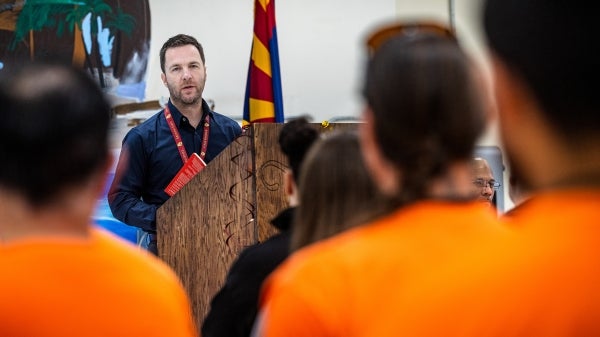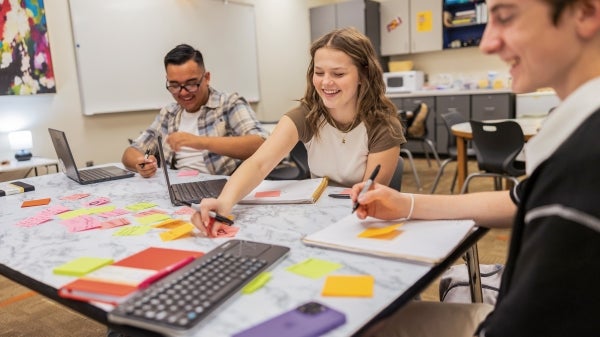Diverse platforms enhance online learning experience

ASU Online partners with several third-party provides to enhance the online learning experience. To view an interactive version of this graphic, visit teachonline.asu.edu/platform
The Global Freshman Academy is unique in many ways — allowing students to take classes before deciding whether to pay for the credit, charging only $200 per class credit and accepting students without requiring SATs or a transcript.
The new program has another innovation as well: It uses a technology that’s so personalized every student learns the class material a different way.
The method comes through a partnership with a Silicon Valley company that provided software that “learns” each student’s knowledge level and presents new lessons and review material at the exact time that the brain is most receptive to them.
“That adaptivity is something we think about when we’re trying to bring out the many ways we’re engaged in inclusiveness,” said Adrian Sannier, chief academic technology officer for ASU Online.
It’s a platform based on memory sciences, developed by the company Cerego, which specializes in personalized learning.
“We want to help you crystallize that foundational knowledge and know what you know,” Andrew Smith Lewis, Cerego’s co-founder and executive chairman, said during a phone interview.
“User by user, the system can figure out what do you know, what do you need to know and when is the best time for you to learn it. The system constantly updates. The more you use it, the better it gets.”
That precise way of learning, called “personalization” or “adaptivity,” can improve the odds for success, which is also the mission of the Global Freshman Academy, the product of a partnership with Arizona State University and edX that has more than 13,500 students enrolled for its current course on astronomy.
Cerego is one of more than 130 digital partners that ASU Online works with to boost the chances for student success.
Some of the companies are ubiquitous, such as YouTube, where professors post videos, and Facebook, where students can interact. Others provide content, such as graphing animation for engineers (FastFig), simulated chemistry labs (Late Nite Labs) or tutorials (Mastering Physics).
ASU must evaluate the thousands of technology options available to find the perfect fit for its disciplines. The ASU+GSV Summit is one way that the university connects with the latest educational technology. Faculty and ASU Online’s instructional designers also participate.
“It’s still more art than science at this stage,” Sannier said of pinpointing the best technology.
“You’d like to say the way we know what works is that everything has been measured for efficacy, and that isn’t always the case.”
Sannier said that ASU and Pearson, the international education company, are jointly starting a new lab to hone in on the best way to measure the effectiveness of online tools.
Although ASU often goes outside to partner on ways to improve online learning, the most crucial part of the online course — the content — is entirely driven by ASU professors.
“The faculty process for choosing content goes back to the way faculty traditionally chose textbooks — from their own research and their own preferences,” Sannier said. “But now we’re starting to see the technology and content begin to blend as more publishers find ways to augment their content with services to enhance them.”
For example, he said, “McGraw Hill’s LearnSmart takes what I think of as a traditional textbook content and enhances it so the student can study major concepts and keep track of things they know.”
ASU Online has made great progress in personalization, starting four years ago when remedial math classes were taught using this technology.
“Personalization can help students make progress more quickly and also make sure the student, particularly if they come to a general-education subject underprepared, can fill in the holes without requiring everyone else in the class to participate in that same study,” Sannier said.
The methods are having a positive effect. Passing rates went from about 50 percent to more than 70 percent in those classes using personalization.
ASU Online is now piloting personalized learning in “hybrid” physics and biology classes, with part of the classes online and part face-to-face.
Sannier said that using the online class method can free up faculty to do more projects and activities during class time.
And Cerego’s Smith Lewis has found that professors at other universities have been able to do away with some quizzes and tests, instead relying on the personalization technology to prove that students have mastered the coursework along the way.
“It could take students three hours or it could take eight hours to do. The instructor sets the goal and the students go for it.”
To view an interactive version of the graphic pictured above, visit teachonline.asu.edu/platform.
More Arts, humanities and education

ASU professor, Arizona inmate work to rehabilitate the 'imprisoned mind'
An Arizona State University professor has collaborated with an Arizona inmate on a book that examines why investing in healing…
Illuminating legacy at ASU
In 2020, the ASU Art Museum unveiled a groundbreaking installation, "Point Cloud (ASU)," by renowned artist Leo Villareal. The…

Name change for ASU's Mary Lou Fulton Teachers College reflects college's mission
Arizona State University’s Mary Lou Fulton Teachers College has a new name: the Mary Lou Fulton College for Teaching and Learning…